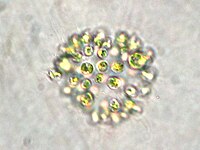
Photo from wikipedia
Microcystins produced during harmful cyanobacterial blooms are a public health concern. Although patterns are emerging, the environmental cues that stimulate production of microcystin remain confusing, hindering our ability to predict… Click to show full abstract
Microcystins produced during harmful cyanobacterial blooms are a public health concern. Although patterns are emerging, the environmental cues that stimulate production of microcystin remain confusing, hindering our ability to predict fluctuations in bloom toxicity. In earlier work, growth at cool temperatures relative to optimum (18°C vs. 26°C) was confirmed to increase microcystin quota in batch cultures of Microcystis aeruginosa NIES-843. Here, we tested this response in M. aeruginosa PCC 7806 using continuous cultures to examine temporal dynamics and using RNA-sequencing to investigate the physiological nature of the response. A temperature reduction from 26 to 19°C increased microcystin quota ∼2-fold, from an average of ∼464 ag μm–3 cell volume to ∼891 ag μm–3 over a 7–9 d period. Reverting the temperature to 26°C returned the cellular microcystin quota to ∼489 ag μm–3. Long periods (31–42 d) at 19°C did not increase or decrease microcystin quota beyond that observed at 7–9 d. Nitrogen concentration had little effect on the overall response. RNA sequencing indicated that the decrease in temperature to 19°C induced a classic cold-stress response in M. aeruginosa PCC 7806, but this operated on a different timescale than the increased microcystin production. Microcystin quota showed a strong 48- to 72-h time-lag correlation to mcy gene expression, but no correlation to concurrent mcy expression. This work confirms an effect of temperature on microcystin quota and extends our understanding of the physiological nature of the response.
Journal Title: Frontiers in Microbiology
Year Published: 2020
Link to full text (if available)
Share on Social Media: Sign Up to like & get
recommendations!